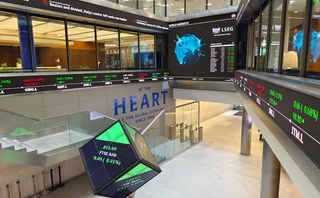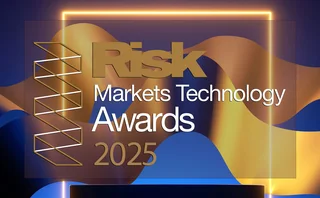
Exchange of the year: Intercontinental Exchange
Risk Awards 2022: Amid Brexit and benchmark transition, Ice fulfils Abu Dhabi exchange ambition

Preparing for Libor’s end has been an uphill struggle for market participants of all stripes. For exchanges with flagship contracts pegged to the outgoing benchmarks, adaptation has been a matter of survival. For Intercontinental Exchange (Ice), which owns the rate via its Ice Benchmark Administration (IBA) arm and is also home to sterling Libor-linked futures and options, a smooth transition was imperative.
It wasn’t the only headwind the exchange faced in 2021. When the Brexit transition period expired at the end of 2020 without an equivalence deal for trading venues, European users of London-based Ice Futures Europe saw their listed contracts tip into the over-the-counter regime. Ice swiftly shifted its entire European carbon trading operation to Amsterdam.
Against this turbulent backdrop, Ice brought to fruition a 15-year ambition: opening a new exchange in the Middle East to link oil exporters with rapidly developing markets across Asia.
In March, the group opened Ice Futures Abu Dhabi (IFAD). The exchange is home to the first futures contract referencing Murban crude oil – the main crude exported by the United Arab Emirates.
The new venue addresses a specific pricing problem. The UAE’s state-run oil producer, Abu Dhabi National Oil Company (Adnoc) priced crude exports via an ‘official selling price’ (OSP), which is selected by the government using a retroactive methodology. While this approach suited many producers, it proved inconvenient for buyers and traders of the product, given a lack of transparency and the fact prices were set two months in advance.
“The OSP meant it was practically impossible to hedge the price risk you faced on Murban,” says Stuart Williams, president of Ice Futures Europe. “Retroactive OSPs worked well for producers up until about 2015, when the US became a significant exporter.”
The arrival of the US as a mainstream producer has increased competition, Williams says. With a wider range of options available to Asian refiners, producers like Adnoc, which sell to almost every Asian country, began to consider the merits of a market-based pricing mechanism.
While China still buys most of its oil from OPEC nations – with almost half of its crude imports sourced from Middle Eastern countries in 2020, according to World’s Top Exports – the US was its second fastest-growing supplier in 2020, with exports up almost 90% on the previous year.
The introduction of market pricing means customers can contribute to price formation, access forward curves and hedge exposures with futures products.
Williams says IFAD’s Murban futures are now used to price all of Adnoc’s crude exports – 3.5 million barrels a day. This represents around 4% of global oil consumption, based on data from Statista.
Building a new exchange is no small feat. More than a decade in the making, the mammoth project was conducted in association with the UAE. Williams says the decision to launch a new exchange rather than simply adding the contract to Ice’s existing venues, reflects a preference for the contract to be traded in its own regulatory region.
“It’s been clear over the year that the Middle East prefers a local benchmark. There’s local pride, and a desire to diversify the economies in those regions,” Williams says. “We clear IFAD in Ice Clear Europe, where all of our global energy clears, so we don’t lose any capital efficiencies by creating a new exchange.”
More than one million Murban futures contracts traded by year end, with more than 60 buyers across Asia. Early reviews are positive.
“Back in the day, we couldn’t hedge UAE crude; whatever the UAE set as the price we had to take, with no way to manage the risk,” says one Singapore-based oil trader. “So now we have this Murban contract, we use the futures settlement price every day. It’s fair, people can trade it and it’s transparent. There’s liquidity further down, so you can hedge further out which, for a new futures contract, is quite impressive.”
Bye-bor
Four Libor currencies met their end in 2021; sterling, Japanese yen, Swiss franc and euro. For Ice Futures Europe, this meant building liquidity in new futures and options contracts linked to successor risk-free rates (RFRs) ahead of a year-end conversion for over three million legacy Libor contracts.
“Libor migration represents a seismic shift in the rates market and presents a significant challenge to the market, its users and to us as an infrastructure provider,” says Steven Hamilton, Ice’s global head of financial derivatives. “We wanted to make sure our users have the widest offering possible to manage their interest rate exposures as we move into a post-Libor world.”

The exchange’s primary focus was the switch from sterling Libor to its successor, the sterling overnight index average (Sonia). Yet the exchange has also delivered products in Saron, the alternative for Swiss Libor and the secured overnight financing rate (SOFR), a successor for US dollar Libor, which was given a stay of execution until June 2023.
Ice launched Sonia futures contracts in 2017. While the exchange enjoyed dominance in Libor-linked short-sterling futures, it faces fierce competition in the RFR. Competitor CME offers Sonia products including futures with quarterly International Money Market dates and monetary policy committee dates. Curve Global, backed by the London Stock Exchange Group has already thrown the towel in on its own Sonia futures ambitions, eventually shutting its doors on January 28.
Hamilton believes Ice Futures Europe will retain its dominance thanks to an unrivalled product range, including both futures and options.
The December 2020 launch of Sonia options proved an immediate hit; just nine months into trading, open interest exceeded three million contracts, overtaking Libor equivalents in maturities beyond the December 2021 end-date. By late September, the exchange had traded more than £40 trillion notional of Sonia futures and options.
Customers were quick to commend the exchange’s benchmark transition efforts, particularly when grappling with complex topics or instruments; one Ice client recalls a staffer from the exchange – an ex-swaps trader – making a number of office visits to tutor them on Eris swap futures products. Others praise the exchange’s targeting of liquidity programmes and product launches.
Against this hive of transition activity, the group’s benchmark administration arm was responsible for an orderly wind-down of the rate itself. IBA consulted on benchmark cessation in December 2020, eventually confirming end-dates in March 2021 – a move that triggered the setting of market-wide conversion spreads. With its highest profile products on the way out, IBA launched new indexes reflecting compounded-in-arrears versions of overnight RFRs. Intended to simplify compounding for bond and lending markets, indexes were launched for sterling, US dollar, euro and Japanese yen, offering an array of conventions around look-back dates, and zero-floor options.
Going Dutch
Brexit posed a major challenge for UK exchanges. While the need for equivalence had been well flagged for clearing houses, trading venues found themselves locked out of a temporary equivalence regime.
With Ice Futures Europe no longer recognised as a venue by European Union regulators, contracts held by European customers were no longer recognised as listed instruments. This sudden rise of OTC exposures threatened to tip some holders through the ‘NFC-plus’ threshold under the European Markets Infrastructure Regulation (Emir). Currently set at €3 billion ($3.42 billion) in OTC derivatives notional, the move would expose them to more stringent regulatory requirements, including mandatory clearing and margining charges.
In response, Ice took the decision to shift its European carbon trading operation from London’s Ice Futures Europe to Ice Endex in the Netherlands. Yet flagship energy contracts including WTI Crude Oil futures remained in London.
Ice’s Williams says that the firms affected – largely European utilities – must decide whether to reduce their exposures in certain instruments to remain below the threshold or shoulder the regulatory burdens that come with growth.
“Larger firms are already NFC-plus and are unimpacted; smaller firms fall below the three-billion threshold,” Williams says. “It’s the medium-size firms which are affected. Do they reduce exposures, or become NFC-plus? Considering energy volatility right now, not having access to liquidity is tough, so a number of firms are looking at becoming NFC-plus.”
The equivalence issue, however, was not the main reason for the move to Endex, Williams adds; he sees carbon markets as unique. While most commodity markets are based on the extraction and delivery of physical materials, carbon trade is created directly by policy, meaning trading is best located within its own regulatory regime.
“We felt, almost regardless of the impact of the exchange equivalence issue, that carbon markets need to be hosted in the jurisdiction for which the policy is defined,” Williams says. “Brexit and the UK exiting the EU emissions trading scheme, was the biggest driver, rather than the question of exchange equivalence. We’ve put all of our energy products in Ice Clear Europe, but we’ve been thoughtful about where the execution location of the various markets needs to be.”
Only users who have a paid subscription or are part of a corporate subscription are able to print or copy content.
To access these options, along with all other subscription benefits, please contact info@risk.net or view our subscription options here: http://subscriptions.risk.net/subscribe
You are currently unable to print this content. Please contact info@risk.net to find out more.
You are currently unable to copy this content. Please contact info@risk.net to find out more.
Copyright Infopro Digital Limited. All rights reserved.
As outlined in our terms and conditions, https://www.infopro-digital.com/terms-and-conditions/subscriptions/ (point 2.4), printing is limited to a single copy.
If you would like to purchase additional rights please email info@risk.net
Copyright Infopro Digital Limited. All rights reserved.
You may share this content using our article tools. As outlined in our terms and conditions, https://www.infopro-digital.com/terms-and-conditions/subscriptions/ (clause 2.4), an Authorised User may only make one copy of the materials for their own personal use. You must also comply with the restrictions in clause 2.5.
If you would like to purchase additional rights please email info@risk.net
More on Awards
Clearing house of the year: LCH
Risk Awards 2025: LCH outshines rivals in its commitment to innovation and co-operation with clearing members
Best use of machine learning/AI: CompatibL
CompatibL’s groundbreaking use of LLMs for automated trade entry earned the Best use of machine learning/AI award at the 2025 Risk Markets Technology Awards, redefining speed and reliability in what-if analytics
Markets Technology Awards 2025 winners’ review
Vendors jockeying for position in this year’s MTAs, as banks and regulators take aim at counterparty blind spots
Equity derivatives house of the year: Bank of America
Risk Awards 2025: Bank gains plaudits – and profits – with enhanced product range, including new variants of short-vol structures and equity dispersion
Law firm of the year: Linklaters
Risk Awards 2025: Law firm’s work helped buttress markets for credit derivatives, clearing and digital assets
Derivatives house of the year: UBS
Risk Awards 2025: Mega-merger expected to add $1 billion to markets revenues, via 30 integration projects
Interest rate derivatives house of the year: JP Morgan
Risk Awards 2025: Steepener hedges and Spire novations helped clients navigate shifting rates regime
Currency derivatives house of the year: UBS
Risk Awards 2025: Access to wealth management client base helped Swiss bank to recycle volatility and provide accurate pricing for a range of FX structures







